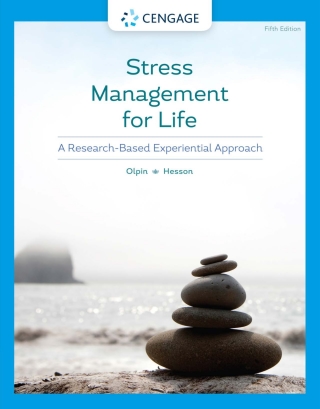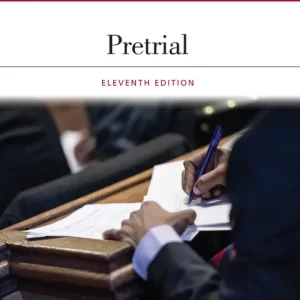Buy Stress Management for Life: A Research-Based Experiential Approach, 5th Edition PDF ebook by author Michael Olpin; Margie Hesson – published by Cengage Learning in 2021 and save up to 80% compared to the print version of this textbook. With PDF version of this textbook, not only save you money, you can also highlight, add text, underline add post-it notes, bookmarks to pages, instantly search for the major terms or chapter titles, etc.
You can search our site for other versions of the Stress Management for Life: A Research-Based Experiential Approach, 5th Edition PDF ebook. You can also search for others PDF ebooks from publisher Cengage Learning, as well as from your favorite authors. We have thousands of online textbooks and course materials (mostly in PDF) that you can download immediately after purchase.
Note: e-textBooks do not come with access codes, CDs/DVDs, workbooks, and other supplemental items.
eBook Details:
Full title: Stress Management for Life: A Research-Based Experiential Approach, 5th Edition
Edition: 5th
Copyright year: 2021
Publisher: Cengage Learning
Author: Michael Olpin; Margie Hesson
ISBN: 9780357363966, 9780357364178
Format: PDF
Description of Stress Management for Life: A Research-Based Experiential Approach, 5th Edition:
STRESS MANAGEMENT FOR LIFE: A RESEARCH-BASED EXPERIENTIAL APPROACH, 5th Edition is a text that students will keep and use long after they finish the class. Many will share it with their stressed-out friends and family. In an easy-to-understand, friendly style, readers will not only learn how stress happens, based on leading-edge science, but more importantly, what works to turn off their stress and the symptoms that accompany chronic stress. This book gives readers the experience of real stress relief and empowers readers to prevent stress for the rest of their lives. Stress Management for Life is a life-changing experience.Important Notice: Media content referenced within the product description or the product text may not be available in the ebook version.
Table of Contents of Stress Management for Life: A Research-Based Experiential Approach, 5th Edition PDF ebook:
Brief ContentsContentsPrefaceChapter 1: Stress in Today’s World1.1 Stress in Today’s World1.2 Stress: What Is It?1.3 Yerkes-Dodson Principle1.4 The Terminology of Stress1.5 Holistic Health1.6 Dimensions of Health1.7 Nature or Nurture1.8 Sources of Stress1.9 ConclusionChapter 2: Self-Assessment2.1 Self-Assessment2.2 Where are you Now Stress-Wise?2.3 Assess Your Stress2.4 Symptoms of Stress: Assessment2.5 Perceived Stress Scale (PSS)2.6 Inventory of College Students’ Recent Life Experiences2.7 Ardell Wellness Stress Test2.8 Student Stress Scale2.9 Stress Vulnerability Factors2.10 Tombstone Test2.11 Daily Stress Diary2.12 ConclusionChapter 3: The Science of Stress3.1 The Science of Stress3.2 Stress and the Big Bear3.3 The Fight-or-Flight Response3.4 Physiological Response to Stress3.5 The Stress Response in Today’s World3.6 The General Adaptation Syndrome3.7 The Stress Response and You3.8 Five Myths About Stress3.9 ConclusionChapter 4: The Mind/Body Connection4.1 The Mind/Body Connection4.2 Psychological Health4.3 The Role of Chronic Stress in Disease4.4 Medium-Term Chronic Stress4.5 Long-Term Chronic Stress4.6 How the Mind and Body Communicate4.7 ConclusionChapter 5: The Power of Perception5.1 The Weeds Crowd Out the Flowers5.2 The Power of Perception5.3 Perception5.4 The World is NOT a Stressful Place5.5 Cognitive Restructuring5.6 Hardiness5.7 Putting it All Together5.8 ConclusionChapter 6: Thinking and Choosing6.1 Thinking and Choosing6.2 Cognitive Distortions6.3 Thinking Errors6.4 Cognitive Techniques That Help Overcome Distorted Thinking6.5 Underlying Theories and Practices6.6 Rational Emotive Behavior Therapy6.7 ConclusionChapter 7: Mindfulness7.1 Mindfulness7.2 The Nature of Reality7.3 The Here and Now7.4 Understanding Mindfulness7.5 Qualities of Mindfulness7.6 Mindfulness as a Way of Being7.7 Why Be Mindful?7.8 Benefits of Mindfulness7.9 Experiencing Mindfulness: Testing the Principle7.10 A Simple Mindful Exercise7.11 Inner Mindfulness Meditation7.12 Ways to Practice Being More Mindful7.13 Planning for the Future7.14 Putting it All Together7.15 ConclusionChapter 8: Managing Emotions8.1 Managing Emotions8.2 The Physiology of Emotion8.3 Guilt and Worry8.4 Fear8.5 Putting it Together8.6 Anger8.7 Hostility8.8 ConclusionChapter 9: The Importance of Values9.1 The Importance of Values9.2 Understanding Your Values9.3 Carried Away in Mediocrity9.4 Source of Values9.5 Values within Cultures9.6 The Dynamic Quality of Values9.7 Acquiring Values9.8 Beliefs about Values9.9 Types of Values9.10 Values Clarification9.11 Creating Your Personal Constitution9.12 ConclusionChapter 10: Spirituality10.1 Spirituality10.2 The Spiritual Quest10.3 Spirituality and Religiosity10.4 Research on Spirituality10.5 Five Qualities of Spiritual Health10.6 An Action Plan for Stress Management Through Spiritual Wellness10.7 ConclusionChapter 11: Time and Life Management11.1 Time and Life Management11.2 What is Time Management?11.3 Time and Stress11.4 Planning for Control11.5 ABC123 Prioritized Planning11.6 Quadrant Planning11.7 Lifebalance11.8 Keys to Creating Balance11.9 Serendipity11.10 Procrastination11.11 Digital Time and Life Management11.12 ConclusionChapter 12: Money Matters12.1 Money Matters12.2 The ABCs of Money Management12.3 Doodads and Credit Cards12.4 Stress on the Job12.5 Additional Tips for Managing Your Money12.6 Can Money Make You Happy?12.7 Putting it All Together-What the Experts Say12.8 ConclusionChapter 13: Social Support, Relationships, and Communication13.1 Social Support, Relationships, and Communication13.2 Social Support13.3 Relationships13.4 Communication13.5 Managing Conflict13.6 ConclusionChapter 14: Creating a Healing Environment14.1 Creating a Healing Environment14.2 Stress and the Environment14.3 A Healing Environment14.4 Color14.5 Light14.6 Odors and Air14.7 Noise14.8 Temperature14.9 Taking Control of Your Surroundings14.10 Ergonomics14.11 Technology and the Environment14.12 ConclusionChapter 15: Healthy Lifestyles15.1 Healthy Lifestyles15.2 Exercise15.3 Nutrition15.4 Stress and Healthy Weight15.5 Eating Disorders15.6 Sleep15.7 Lifestyle Behaviors to Avoid15.8 ConclusionChapter 16: Introduction to Relaxation16.1 Introduction to Relaxation16.2 Understanding Relaxation16.3 Benefits of Relaxation16.4 Getting Started16.5 Relaxation Sensations16.6 Use Good Judgment16.7 Time for a Nap-A Power Nap16.8 Doing the Power Nap16.9 ConclusionChapter 17: Take a Breath17.1 Take a Breath17.2 Background17.3 How Breathing Works17.4 Benefits of Relaxing Breathing17.5 Breathing and Relaxation17.6 How to Do Relaxing Breathing17.7 Breathing Exercises17.8 ConclusionChapter 18: Autogenics18.1 Autogenics18.2 Background of Autogenic Training18.3 How Autogenics Works18.4 Benefits of Autogenics18.5 Experiencing Autogenics18.6 A Simple Autogenics Script18.7 ConclusionChapter 19: Progressive Relaxation19.1 Progressive Relaxation19.2 Background19.3 Muscle Physiology19.4 Muscles and Relaxation19.5 How PMR Works19.6 Benefits of Progressive Relaxation19.7 How to Do Progressive Muscle Relaxation19.8 ConclusionChapter 20: Guided Imagery: Using Your Imagination20.1 Guided Imagery: Using Your Imagination20.2 Background20.3 The Mind and How It Works20.4 Imagery and Visualization20.5 Uses of Imagery20.6 Relaxation Guided Imagery: What Is It?20.7 Benefits of Guided Imagery20.8 Guided Imagery as a Technique for Relaxation20.9 ConclusionChapter 21: Meditation21.1 Meditation: It’s Not What You Think21.2 Meditation: What Is It?21.3 What Meditation Is Not21.4 Meditation Put into Practice21.5 Additional Ways to Meditate21.6 Benefits of Meditation21.7 Frequently Asked Questions about Meditation21.8 ConclusionChapter 22: Yoga22.1 Yoga22.2 Background22.3 Overview of Yoga Styles22.4 Benefits of Yoga22.5 Hatha Yoga22.6 How to Practice Yoga22.7 Taking Precautions Before Starting Yoga22.8 Additional Tips to Enhance Your Yoga Experience22.9 Finding a Yoga Class22.10 Sample Poses22.11 ConclusionChapter 23: Complementary and Alternative Health23.1 Complementary and Alternative Health23.2 Understanding Complementary and Alternative Health23.3 Categories of Complementary and Alternative Medicine23.4 Applications of the 5 Categories of CAM to Stress Management23.5 Types of Massage23.6 ConclusionChapter 24: What Else Can I Do?24.1 More Stress-Reduction Strategies24.2 Laughter and Humor24.3 Music24.4 What Else Can I Do?24.5 “Solutions” to Avoid24.6 Stress Management for Life-Planning for the Future24.7 ConclusionGlossaryIndex





